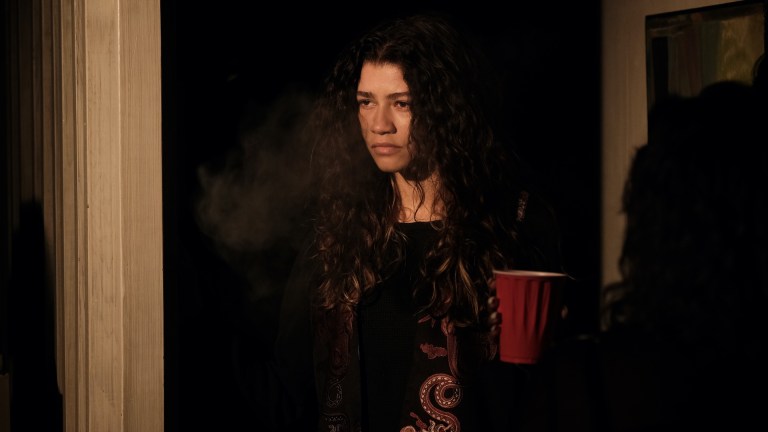Who is Euphoria For?
HBO high school drama Euphoria is impossibly grim...and that's kind of the whole point.

If you were to tune in to the first episode of Euphoria season 2 out of curiosity, you would get hit with a trademark of the popular show’s identity right out of the gate.
In the first episode “Trying to Get to Heaven Before They Close the Door”, you’d see a badass looking blonde woman get out of a car and enter a strip club. With a firearm bound to her hand, she enters the back of the joint to confront an obese man who is receiving oral sex in a rolling chair. Most shows would stop you right there. They would obscure the graphic act being performed in the story, cut to a different angle, and have faith that you don’t need to see the whole ballpark frank to know what is happening.
That’s not how Euphoria does things. The man’s entire penis is exposed, in clear sight of the audience, children, God, and everyone else. The women then takes her pistol and shoots the man in every leg except the middle one, leaving him screaming bloody murder, and departs the room like an OG. In fact, “the motherfucking G” is exactly what they call her. She’s the grandmother of one of the main characters from season one, Fez, and we are receiving some backstory as to why he’s now one of the main drug dealers in the show’s universe.
If you have heard anything about the show before, you may not be completely baffled, but Twitter users around the world still echoed the shocked sentiments of many other probable first-time viewers.
Depictions of graphic violence and nudity have been done before on other HBO shows like Game of Thrones, but not quite like on Euphoria. That’s because the former is about a fantastical land of dragons and kingdom-seeking warlords, and the latter is about a typical middle-class American high school.
Or is it typical? Euphoria depicts a certain sector of the American high school populace. A subsect of youth culture that would make even Harmony Korine blush at some points. The characters do more drugs than the Rolling Stones, and they have more sex than Ron Jeremy. One scene last season showed one of the antagonists of the show, Nate Jacobs (Jacob Elordi), walking through a locker room after a football game, amid a field of so many flaccid penises. I guess the show decided to continue that tradition immediately in season two.
So why is there so much dick on Euphoria? Why are there so many enormous breasts? And big asses? And rape scenes? And face bludgeonings? Why is this all happening to about a dozen high school-aged kids at the epicenter?
Who exactly is Euphoria for? Is it for the parents of a generation that has more of these risk factors thrown their way than any other one in history? Is it for now-adults to relive past traumas that resemble the ones on screen? To have a cathartic release for sins that were committed in their past adolescence? Or is it for no specific group at all – a fantasy world for adults and teens alike to watch vicariously?
It’s certainly not for the audience of star Zendaya’s Disney-littered origins. It also might not be for the people who are currently enjoying her brilliant turn as Peter Parker’s (and Tom Holland’s) girlfriend in the MCU Spider-Man films (and in real life). The decorated actress is still only in her mid-20s, yet she has enough on her resume that she could retire right now and be remembered for decades.
And it’s her take on the titular character of this show that has garnered her the most critical acclaim yet. She became the youngest woman ever to win the Emmy for Outstanding Lead Actress in Drama Series for the first season. She’ll surely be in the running again for this second season. Playing the drug-addicted Rue, Zendaya has given a voice to those who have no direction, because that potential has been completely stolen by substance abuse and mental health hell. Her pain is visceral, but she lends an innocence and a sympathy from the audience that makes it impossible to look away.
The actress has talked before about the profound impact the story has had on audiences all over the world:
“To me, when people have come up to me, at least, and shared their stories, whether it be of sobriety or other entry points to different characters that they feel connected to emotionally, that’s when I’m like, ‘You know, this is worth it’. Like, what we’re doing means something to somebody and that’s all we could ever really hope for. That’s the point. You know, that’s the purpose.”
Even her one-word gawking at Fez assaulting Nate at the end of season 2’s first episode is enough for us to connect with her sense of nonchalance and light-hearted humor, something that is usually drowned in the character’s typical sorrow.
Rue is not the only character going through the gamut though. The show presents its audience with other troubled teens who have equally horrific backstories. The aforementioned Nate has a dad who is a sexual predator. Jules (Hunter Schafer), Rue’s love interest in the first season, is combating identity issues and coming to terms with the aftermath of gender dysphoria and hormone replacement therapy. Kat (Barbie Ferreira) is trying to find confidence in all the wrong places after a lifetime of being rejected by fatphobic classmates.
The show is, in many ways, a survey of the worst possible lives teenagers could exist in during their high school years. It doesn’t give hope for the future, and it certainly doesn’t sugarcoat or coddle the audience. If you’re looking for a John Hughes flick to be emulated on your television shows in 2022, there are several other options that come to mind.
But it also gives the viewer strength by simply existing. By having, dare I say, the balls to go all the way and shove these atrocities down our throats, creator Sam Levinson has given a template for even the lowest common denominators in teenage society. It allows someone who is at rock bottom, no matter their age, gender identity, or sexual orientation, to see their story on premium cable.
But what if what you’re seeing isn’t your story? Let’s be honest, some kids actually do go home to a church choir mother who cuts the crusts off of their sandwiches and a dad who has the new PlayStation at the ready on launch day. What if that is your story? The one where your upbringing resembles Full House rather than Precious.
Then you’re going to get to see the other side of the coin. The type of teenage existence that the show based off of creator Levinson’s own youth. He talked about his perspective on the events happening on screen and how they are relatable to certain demographics of American society with EW back in 2019:
“I just wrote myself as a teenager. I think those feelings and memories they’re still extremely accessible to me. So it’s not a hard reach. I just write myself and what I was feeling and what I was going through when I was younger and I was dealing with addiction.”
Keeping this in mind, it feels like Euphoria is for anybody who will listen. It’s for anybody who wants to see themselves, or see someone else. The show is a case of sensory overload, a bombastic cinematic endeavor that fills every orifice with genitals, illegal substances, and iconic ‘80s music. It’s a beacon of hope that every program will eventually want their audience to taste, touch, hear, see, and smell the environment of the setting.
We’ve talked a lot about whether TV is now an art form, and Euphoria is the Statue of David, quite literally. A show that has no fears about displaying exactly what they mean. They show and tell the audience how to think and feel. Whether that’s a good or a bad thing is still up for interpretation.
And if this explanation of the show seems a little too philosophical or even a tad verbose, then take this Twitter user’s summary and be on your way.
Yup. That’s what Euphoria is.
